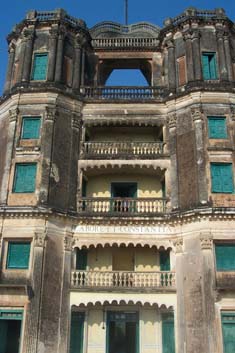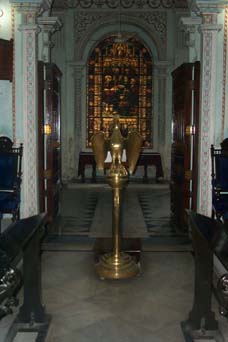
 |
The
College consists of a magnificent eighteenth century building,
to which other imposing structures have been periodically added.
“Constantia”, the imposing centre-point of La Martiniere, was
the country house of Major-General Claude Martin. The majestic
column or “Lat” that rises beside it is a memorial to him.
Major-General Claude Martin died on 13 September, 1800. Under his will, dated 1 January, 1800, certain funds were allotted for the establishment of schools at Lyon, his birth place in France, in Calcutta and at Lucknow. The residue of his estate after certain bequests had been made was to be used for the maintenance of these schools, this residue being equally divided amongst them. In his will Claude Martin directed that “my house at Luckperra or Constantia House with all the ground and premises belonging to the house and all the ground around it, none is to be sold or detached from it.” The will went on to define his purpose which was “for to keep the said Constantia House for school or College for learning young men the English language and Christian religion if they found themselves inclined.” |
|
For more than a generation after
Major-General Claude Martin’s death in 1800, there was a great
deal of litigation over his will. Consequently on 11 April,
1839, the Supreme Court at Calcutta decreed “that a college
at Lucknow be established pursuant to the will of Claude Martin.”
A further decree of the Supreme Court dated 22 December, 1841,
laid down a scheme for the establishment of La Martiniere College,
at Lucknow. As such, La Martiniere College, Lucknow, occupies
a unique position amongst the schools in India and the erstwhile
British Empire.
The first Principal of La Martiniere College, Lucknow, Mr John Newmarch, recorded on 12 November, 1845. “The College began work on the 1st October last.” This date, 1 October, 1845 is taken as the actual beginning of the College. Starting with about seventy boys, the strength on the rolls has now crossed 2,200, divided in classes ranging from the Nursery to the Intermediate levels. Owing to the munificence of the Founder, Major-General Claude Martin, many boys called Foundationers are provided tuition, clothing, board and lodging at nominal fees. This is possible only because the Founder left money specifically for this purpose. Full paying Boarders and Day Scholars make up the numbers. All scholars share equally in the benefits of the College without preference in respect of religion or economic status. |
 |
 |
War came to Lucknow in a big
way in 1847 and the College was evacuated to the Residency on
13 June, 1857, on the orders of Sir Henry Lawrence although,
the Principal, George Schilling, had fortified the school buildings
and stocked provisions with the intention of defending La Martiniere.
During the stirring events of 1857 the Principal, Masters and
boys of La Martiniere played a role which is perhaps unique
in the history of the British Empire. They defended an extremely
exposed part of the southern perimeter, withstood infantry and
artillery attacks and were subjected to mining operations. In
the face of great hardship they ably and successfully defended
“The Martiniere Post” for almost five months. Meanwhile studies
continued. In 1938 as recognition of the role played by them,
the College was awarded colours bearing the legend “Defence
of Lucknow, 1857. This is a distinction no other school anywhere
enjoys.
Today, the College is as popular as ever. It imparts instruction through the medium of English and admission to it is eagerly sought. Over the span of one and a half centuries, the College has produced soldiers, sailors and airmen who have done the school and their country proud in the two World Wars and in the wars of Independent India. It has also produced engineers, doctors, educationists, administrators and outstanding sportsmen, now scattered over the globe. |
| On
1 October, 1995, the one hundred and fiftieth Anniversary of the
opening of the College, the President of India, acknowledged the
contribution of the College by releasing a postage stamp of the
denomination of Rs 2, as a mark of honour. This, again, is a mark of distinction which only a few other institutions in India enjoy. |
|
——————————————————————————————————————————